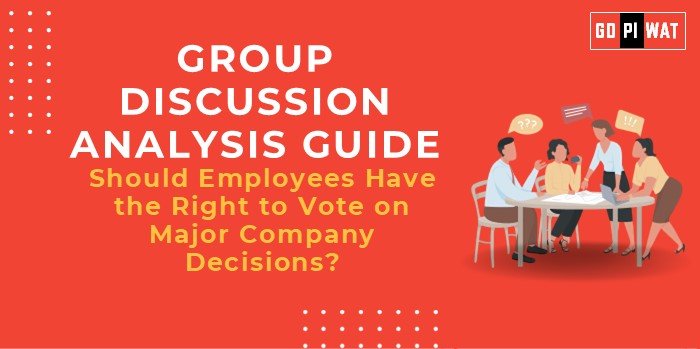📋 Group Discussion Analysis Guide
🌟 Topic: Should Employees Have the Right to Vote on Major Company Decisions?
🌐 Introduction to the Topic
Opening Context: The debate around employee participation in corporate decision-making has gained global traction. While traditional governance vests decision power in shareholders and executives, employee involvement reflects rising trends in workplace democracy and inclusivity.
Topic Background: Rooted in principles of participative management, the idea is inspired by democratic models in companies across Europe, particularly Germany’s co-determination system, where employees elect board members.
📊 Quick Facts and Key Statistics
- 🇩🇪 German Co-Determination: Employees hold up to 50% of board seats in companies with over 2,000 workers.
- 🌍 Global Trust: 61% of employees worldwide feel excluded from corporate decision-making (Gallup, 2023).
- 📈 Profitability Impact: Companies with higher employee engagement show 21% more profitability (Forbes, 2023).
- 👥 Union Influence: Over 35% of employees in Scandinavian firms influence decisions through union voting.
- 🇺🇸 U.S. Model: Shareholder primacy often marginalizes non-executive stakeholders like employees.
👥 Stakeholders and Their Roles
- Employees: Seek greater representation for decision-making transparency and fairness.
- Management/Executives: Concerned about operational efficiency and preserving control.
- Shareholders: Often oppose voting rights for non-investors, prioritizing return on investment.
- Governments/Policymakers: Set frameworks for corporate governance regulations.
- Unions and Worker Bodies: Advocate for collective voting rights on strategic matters.
🏆 Achievements and Challenges
✨ Achievements
- Boosted Engagement: Participatory governance fosters higher morale and lower turnover.
- Transparency: Employees’ insights improve ethical and sustainable practices.
- Global Examples: Germany’s co-determination enhances workplace cooperation.
⚠️ Challenges
- Operational Delays: Decision-making processes risk becoming slow and inefficient.
- Investor Concerns: Shareholder reluctance to share power impacts capital inflow.
- Lack of Expertise: Employees may lack the requisite knowledge for complex decisions.
🌍 Global Comparisons
- Germany: Mandatory employee representation on boards.
- U.S.A.: Shareholder-centric with limited employee participation.
- Scandinavia: Strong union-based voting influence at all corporate levels.
Case Study: Volkswagen AG – A leader in co-determination, employees actively vote on significant policies, driving long-term stability and innovation.
📖 Structured Arguments for Discussion
- Supporting Stance: “Giving employees voting rights aligns with democratic principles, enhances productivity, and ensures long-term sustainability.”
- Opposing Stance: “Employee voting can slow decision-making, cause conflicts of interest, and hinder managerial expertise.”
- Balanced Perspective: “While employees deserve a say in governance for inclusivity, strategic voting rights should focus on operational improvements, not all decisions.”
🎯 Effective Discussion Approaches
- Opening Techniques:
- Statistical Hook: “61% of employees feel excluded—how democratic can corporate governance really be?”
- Case Example: “Volkswagen’s success in balancing employee votes with shareholder power proves its feasibility.”
- Counter-Argument Handling:
- Challenge: “Employees lack expertise.”
- Rebuttal: “Specialized training and committees can bridge this gap.”
🔍 Strategic Analysis (SWOT)
- Strengths: Improved engagement, ethical governance, lower attrition.
- Weaknesses: Potential inefficiencies, conflicts, lack of expertise.
- Opportunities: Training programs, strategic focus on ethical issues.
- Threats: Shareholder resistance, cultural barriers.
🌟 Connecting with B-School Applications
- Real-World Applications: Examining German co-determination models for leadership and operations projects.
- Sample Interview Questions:
- “Do you think workplace democracy improves company performance?”
- “How can organizations balance efficiency with employee representation?”
- Insights for B-School Students: Effective corporate leadership thrives on inclusivity and transparency.


